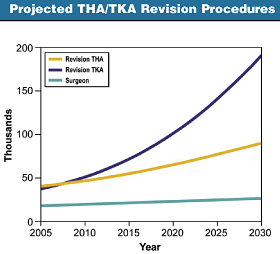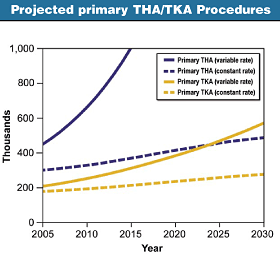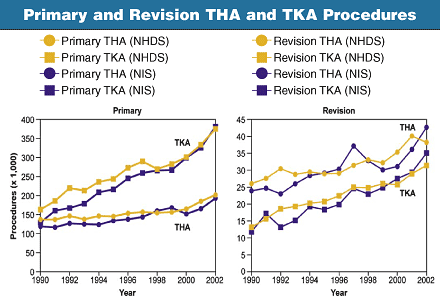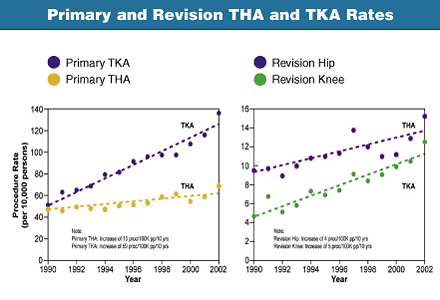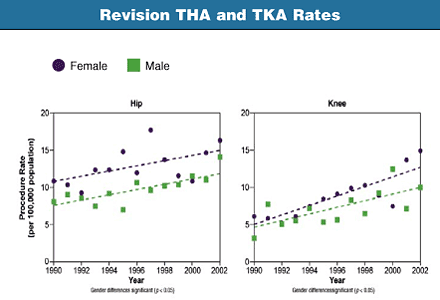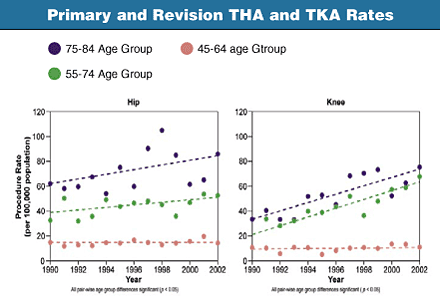Help wanted in 2030: TJR needs will soar, severe surgeon shortage possible
The number of primary TKRs in the United States set to skyrocket by 673%over the next 25 years.
CHICAGO — Researchers have found that in the next 25 years the number of revision total joint replacement surgeries done in the United States will skyrocket, with the greatest increase in demand expected for revision total knee arthroplasties.
Normally such data can be projected from national joint replacement registries, but no such registry currently exists in the United States.
|
Therefore, a team of researchers sought to quantify the number of revision total hip arthroplasty (THA) and total knee arthroplasty (TKA) procedures that might be performed in the United States through 2030. They presented results of their mathematical projection in various formats at the recent American Academy of Orthopaedic Surgeons (AAOS) 73rd Annual Meeting, here.
A look back
The researchers first analyzed the primary and revision THA and TKA surgeries done from 1990 to 2003 in the United States and noticed steady increases in the numbers of both procedures during that period.
When they looked at the number of doctors doing primary and revision procedures, they found that most revisions since 1990 appeared to have been done by relatively few surgeons, according to Steven M. Kurtz, PhD, who presented the results and led the research effort. He is office director and principal engineer of Exponent Inc., Philadelphia, an engineering and scientific research firm.
Back to the future
Next the researchers projected the potential increase in those procedures between 2005 and 2030.
By 2030, they projected, the number of procedures for primary TKA would jump by 673% to 3.48 million. The researchers also estimated that primary THA surgery rates would increase 174% to 572,000 cases.
“There’s definitely going to be a huge need for more orthopedic surgeons,” Kurtz said in a press release. “If the massive expected demand for total joint replacement is not planned for before 2030, patients may end up waiting a long time for a new hip or knee,” said Kurtz, who is research associate professor at Drexel University’s School of Biomedical Engineering, Philadelphia.
Other key projections by the team included the following:
- a slower rate of increase in partial hip replacements (54%);
- a doubling of revision surgeries through 2015 for knee replacements;
- a doubling of revision THA surgeries through 2026; and,
- though hip revisions currently outnumber TKA revision surgeries, that relationship could reverse as early as 2007.
Kurtz and his fellow researchers used the Nationwide Inpatient Sample (NIS) historical database in conjunction with census data to quantify trends for revision surgery rates from 1990 to 2003. For comparison, they also looked at primary procedure rates.
They focused on ICD-9-CM codes 81.51 and 81.53 for primary and revision THA and on 81.54 and 81.55 for primary and revision TKA.
|
|
Although not all of the procedures done by orthopedic surgeons are contained in the NIS database, each year it usually includes procedures done by about 12,000, or 60%, of all U.S. orthopedic surgeons who do THA and TKA surgery, according to the study abstract. It does not track who is doing the procedure, “but we know who’s the same [doctor] doing the same procedures,” Kurtz said when he presented these data at the Orthopaedic Research Society’s Annual Meeting.
For example, the data analysis showed that far fewer surgeons are now performing total hip arthroplasty revision surgeries (47% mean) and total knee revision surgeries (39% mean) than are doing primary surgeries. “Much less than 50% of surgeons are doing revisions, in this case,” Kurtz said.
But, interestingly, as of 2003, “the median surgeons are doing no more revisions than in 1990,” which comes out to about two of each type of revision case annually. Kurtz described median surgeons as those in the 50th-percentile who do an average number of hip and knee arthroplasty procedures, both primary and revision, annually.
In all, 36,000 revision THA and 32,700 revision TKA surgeries had been done in the United States in 2003, with more than half of those patients being women.
Resources needed
To meet the growing need for joint replacements, several kinds of resources will be needed — from more surgeons, to increased economic capacity and longer lasting prostheses, Kurtz reported. The need for more surgeons through 2030 identified in the study was supported by data from two AAOS membership surveys that also projected a need for more physicians. Another factor that plays into this equation: Society shows more acceptance of total joint arthroplasty as a technique that returns the quality of life to patients.
Among the other factors highlighted as critical to the projections are the following: aging population with possibly more risk of arthritis; national trends toward increased activity in some age groups; and a growing prevalence of obesity.
Solutions, approaches
Joshua J. Jacobs, MD, who heads the research and basic science section of Orthopedics Today’s editorial board, noted that Kurtz’ study had identified and quantified the situation quite realistically.
He outlined some possible repercussions if added burdens, such as increased revision arthroplasty rates, were placed on an already financially challenged health care system.
“We’re on a collision course between the demands placed by the Medicare population for services — joint replacement being a major one — and the ability of our society to pay for them,” Jacobs said.
Ways to improve the long-term outlook might include reducing the costs of hip and knee implants, finding better ways of making them last longer, and conducting additional research into better overall joint replacement technology, he said.
A national joint replacement registry could reduce the revision burden, as it did for Sweden by identifying the best-performing primary implants, and the best techniques and practices, Jacobs said.
|
|
|
Courtesy of Exponent |
For more information:
- Kurtz SM, Lau E, Zhao K, et al. The future burden of hip and knee revisions: U.S. projections from 2005 to 2030. SE-53. Presented at the American Academy of Orthopaedic Surgeons 73rd Annual Meeting. March 22-26, 2006. Chicago.

![Steven M. Kurtz, PhD [photo]](/~/media/images/news/print/orthopedics-today/2006/05_may/kurtz_70_90_16693.jpg)
